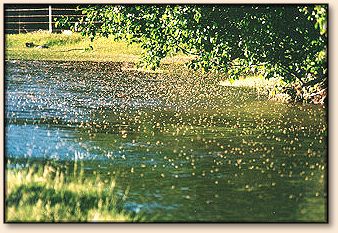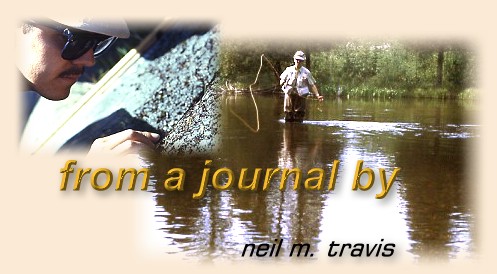A Case for Caddis
By Neil M. Travis, Montana
The mating flies were like a blizzard and dropping to
the water as wind driven snow. Like children attempting
to catch snow flakes on their tongues, the trout were
shattering the surface in an attempt to feast on as
many of these dainty morsels as possible. The angler,
standing in the midst of this blizzard, was barely
discernable amidst the millions of fluttering wings
and cascading bodies. Later he would discover his
waders were covered with thousands of sticky egg
masses left by the mating horde. The flies were so
thick on the water that it was difficult for him to
see his own, but the fish were so eager to fill their
stomachs that they hooked themselves as they engulfed
his artificial. When the onslaught was over he waded
from the river, and sat down on the bank thoroughly
satiated, and suffused with a weariness that comes
from having experienced total exhilaration. A few
stragglers danced over the water but the trout,
completely stuffed from the previous abundance,
ignored their presence.
What insect was this that caused such reckless
intemperance, such wild abandon among creatures that
are normally associated with selectivity and shyness?
Perhaps a hatch of mayflies, those darlings of fly
fishing literature, or perchance an egg laying flight
of bumbling salmon flies intent upon throwing themselves
into the maws of the waiting trout? Most experienced
anglers would recognize this scenario as the description
of an egg laying flight of the caddis. These moth-like
insects are common on trout streams across the country
during the spring and summer months, and generally occur
with greater regularity and consistency than mayflies or
stoneflies. Only midges are more common on most trout
waters than caddis. In addition to consistency and
regularity they generally occur in sufficient numbers
to attract the attention of the resident trout population.
My favorite type of fly-fishing for trout is with small
dry flies, and I really relish the opportunity to fish
with small flies to big fish. The ultimate for me is to
find large trout selectively feeding on small mayfly
spinners, especially just after sunset on a warm summer
evening. Unfortunately I only get this opportunity on
rare occasions since a wide variety of factors must all
come together to engender such an occurrence, however on
many occasions the evening has been rescued by a egg
laying flight of caddis. In the fading light of day
caddis have saved the evening on more than once when
the hoped for spinners never appeared, or were blown
back into the bushes by a late afternoon zephyr.
One such evening occurred many years ago on the Henry's
Fork at Last Chance, Idaho. It was mid-July, and heavy
hatches of pale morning duns had been occurring for
several days, but each evening thundershowers had drowned
the spinner flight before the flies could get to the water.
Each evening I had sat in my vehicle hoping the rain and
wind would cease in time for the spinners to resume their
activity, but for several nights in a row the rain and
wind lasted long enough to remove any opportunity for
the spinners to fly. By the time the last shower had
drifted over the mountains towards West Yellowstone
darkness had descended, and any hope of fishing the
PMD spinners was lost for another evening.
Hope springs eternal in the breast of an angler, and
each night I would pray that the showers would not
appear, the wind would not blow, and the temperature
would not plunge after the sunset. If all these
conditions would come together the spinners would be
able to complete their activity before it got dark,
and I would experience some superb angling opportunities.
Finally the conditions all came together. A warm sunny
day was followed by a cloudless afternoon, the wind
remained calm, and the temperature was mild. I had all
the ingredients necessary, but no spinners appeared.
As the sun edged toward the mountains I searched the
sky in vain for the appearance of a cloud of mating
mayflies, but my watchfulness was to no avail.
Just as the sun began to touch the tops of the peaks
a few caddis began to flutter across the surface of
the water, and as the sun began to disappear, and the
long summer twilight began to deepen, the number of
caddis continued to increase until soon the air above
the water was buzzing with the frantic insects. All
thoughts of mayfly spinners quickly left my mind as
the first egg laying caddis began to fall to the water
and trout began to respond with eagerness.
Under normal summer conditions the Henry's Fork at Last
Chance has a good head of water during the summer months
as water is released from Island Park Reservoir to supply
water for irrigation to downstream ranchers and farmers.
Along the banks the flow is deep enough to encourage the
trout to move into this zone, especially during the
morning and evening hours, and surprisingly large trout
can be found in just a few inches of water. Such were
the conditions on this evening as the trout lined up
along the banks to feed on the caddis bounty. In the
long hour before complete darkness I caught and released
more large trout on the Henry's Fork than I had ever
caught on one occasion on that river. The normally
selective rainbows were like hatchery trout feeding
on pellets. What made the experience even more rewarding
was the fact that besides of my angling companion the
river was devoid of other anglers. Everyone had left
earlier when the spinner flight failed to materialize.

Over the years I have experienced this type of angling
on many occasions. Caddis hatches are generally more
numerous, of longer duration, and of greater intensity
than most any other trout stream insect except midges.
On the Yellowstone the caddis flies have become the
premier insect species during the summer months
starting with the 'Mother's Day' caddis in late April,
and continuing with several other species throughout
the summer. Caddis flies are more tolerant of warm water,
more resistant to pollution, and are found in most types
of aquatic habitats from weed beds to silt and gravel
substrates. Most caddis flies are herbivores feeding
on algae and other types of vegetation, and on the
Yellowstone the increase in caddis numbers might be
attributed to increased enrichment caused by agricultural
and residential runoff. More sterile freestone streams
tend to have marginal numbers of most aquatic insects
including caddis flies.
Caddis flies come in a variety of sizes and colors;
however the most common colors are gray, olive, black
or brown. Most caddis flies on our local waters can
be matched with flies tied on size #14 to #18 hooks,
although an angler may occasionally encounter some
larger species, and micro-caddis hatches do occur.
Caddis fly imitations are easy to tie, with successful
dry flies consisting of just a body, wing and hackle.
Caddis flies are often mistaken for moths since their
wings are moth-like, and when at rest they are folded
over the back of the insect in a tent-like manner. A
well-rounded angler will have a selection of caddis
emergers [wet flies] that can be used to imitate the
emerging and, in some cases, the egg laying forms of
these insects.
Caddis flies are one of the most important trout
stream insects, and every fly fisher needs to be
thoroughly familiar with this significant insect.
I have one entire fly box filled with caddis dry
fly imitations, and another box filled with various
larvae, emergers, and egg laying imitations. Over
the years I have used these imitations as often as
any other, and when I encounter a caddis fly hatch
I always anticipate that fishing will be exciting
and productive. If you are unfamiliar with the caddis,
and you fish with flies it would be more than worth
while to become well acquainted with this common and
prolific trout stream insect. ~ Neil M. Travis, Montana/Arizona
From A Journal Archives
|

